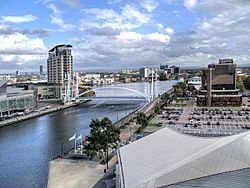Salford Quays lift bridge facts for kids
Quick facts for kids Millennium Bridge |
|
|---|---|

The bridge and Salford Quays
|
|
| Coordinates | 53°28′11″N 2°17′44″W / 53.469638°N 2.295628°W |
| Carries | Pedestrians |
| Crosses | Manchester Ship Canal |
| Preceded by | Media City Footbridge |
| Followed by | Railway swing bridge |
| Characteristics | |
| Design | vertical lift bridge |
| Total length | 91.2 metres (299 ft) |
| History | |
| Engineering design by | Parkman of Manchester |
| Constructed by | Carlos Fernandez Casado |
| Opened | 2000 |
The Salford Quays Millennium Footbridge is a special kind of bridge called a vertical lift bridge. It is also known as the Lowry Bridge or the Salford Quays lift bridge. This bridge is 91.2 meters (about 300 feet) long. It crosses the Manchester Ship Canal in Greater Manchester, England.
This bridge is just for people walking, not cars. It connects Salford Quays and MediaCityUK to Trafford Wharf. It also links to the Imperial War Museum North. The bridge was finished in the year 2000. It can lift up 18 meters (about 60 feet) high. This allows big boats to pass underneath it. You might even see it on the BBC North West Tonight TV news!
Contents
How Was the Bridge Designed?
The idea for the bridge started in 1998. A company called Parkman Ltd from Manchester managed the project. They also designed most of the bridge. Carlos Fernandez Casado was an architect who designed the main part of the bridge.
The main part of the bridge is 91.2 meters (about 300 feet) long. It has a special shape called a Lohse Arch. The two arches are connected at the top. This makes the bridge very strong and steady. The walking path is connected to the arches by vertical bars. These bars spread out as they get closer to the middle.
The arches have colorful LED lights. The walking path has white lights shining down. Glass sides protect people from the wind. These glass panels are blue at the bottom. They also help keep the bridge stable in windy weather. Engineers even tested the glass in a wind tunnel!
How Does the Lifting System Work?
The bridge lifts using four tall, white towers. Inside these towers are heavy counterweights. These weights help the bridge move up and down easily. The counterweights hang from cables over large grey wheels. This system lets the bridge go up or down in less than three minutes. The towers have decorative blue lights at the top.
There is a similar bridge in Plentzia, Spain. It was designed by the same person. This Spanish bridge is a bit bigger, at 108 meters (about 354 feet) long. However, it does not lift up like the Salford Quays bridge.
How Was the Bridge Built?
The company Christiani & Nielsen built the bridge. They used a special method to put the main part of the bridge in place. They floated it on a barge and then moved it between the four towers. Building the bridge cost about 7.5 million US dollars at that time.
The walking path of the bridge is made of a special steel design. This design is very strong and light. It means the towers and lifting parts can be smaller. This also uses less energy to move the bridge. Similar strong steel systems are used for ships and canal lock doors.
The lifting system was designed by Bennett Associates. This company also designed the tilting system for the Gateshead Millennium Bridge. The bridge usually uses electricity from the power grid to lift. But it also has a diesel backup system in case the power goes out.
How Does the Bridge Operate?
The bridge is controlled from a small tower. This tower is on the Salford Quays side of the canal. From here, workers can operate the pedestrian barriers. They also control the lifting mechanism.
Today, very few large ships travel this far up the canal. Because of this, the bridge is not lifted very often. Most of the boats that pass are smaller pleasure boats. You might see more boats between April and October. This is when the Manchester Ship Canal Cruise operates from Liverpool to Salford Quays.

